How do I make a dining room feel cozy? 10 ways with colors, textures and even plants
These expert tips to make the dining room feel cozy mean you can create a wonderful space that helps bring people together

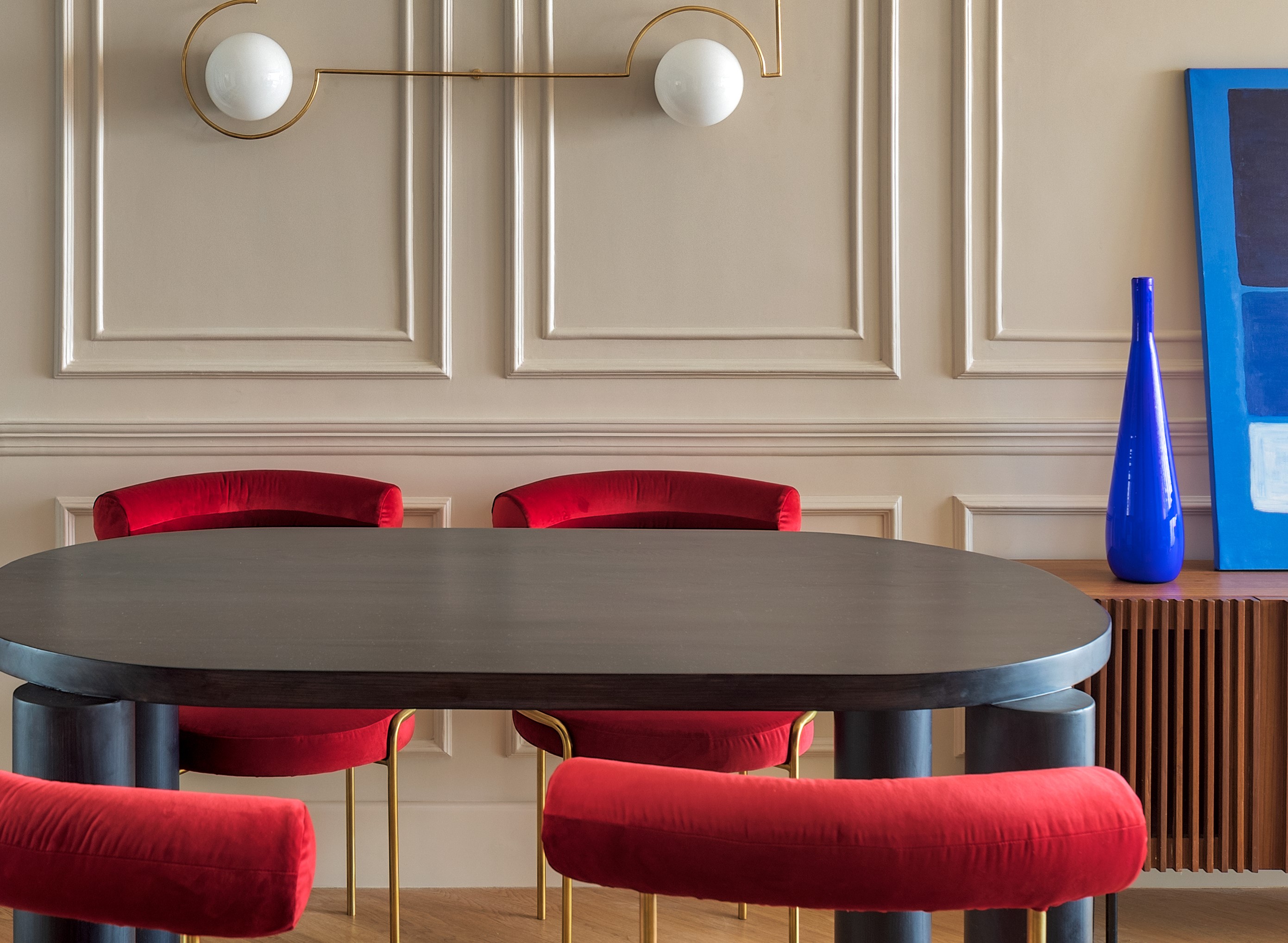
Whether you're taking a solitary moment to sit and read or gathering with the whole family for pancakes on Sunday, the dining room truly is the other heart of the home; a luxury you go to when you when the kitchen doesn't feel quite special enough. It's no doubt that this space needs to be cozy, snug and welcoming, especially with the cold months approaching.
But warming up a room doesn't mean installing a fireplace and calling it a day. Designing a snug space means bringing together several elements, with the right use of color, textures, furniture, even plants. It's possible to make every corner feel convivial, comfortable and warm.
To help you make this space more cocooning, we reached out to experts who know how to make the perfect dining room. Their advice means you can create a cozy dining room tailored for friends, family or just to treat yourself.

Aditi is a homes writer and editor with several years of experience. Her articles, backed by expert insights, offer suggestions aimed at helping readers make the best home design choices. For this article, she spoke to top experts and brands to understand ways to make a dining room look and feel cozy.
10 easily implementable ways to make a dining room cozy
1. Choose warm tones for a cozy feeling
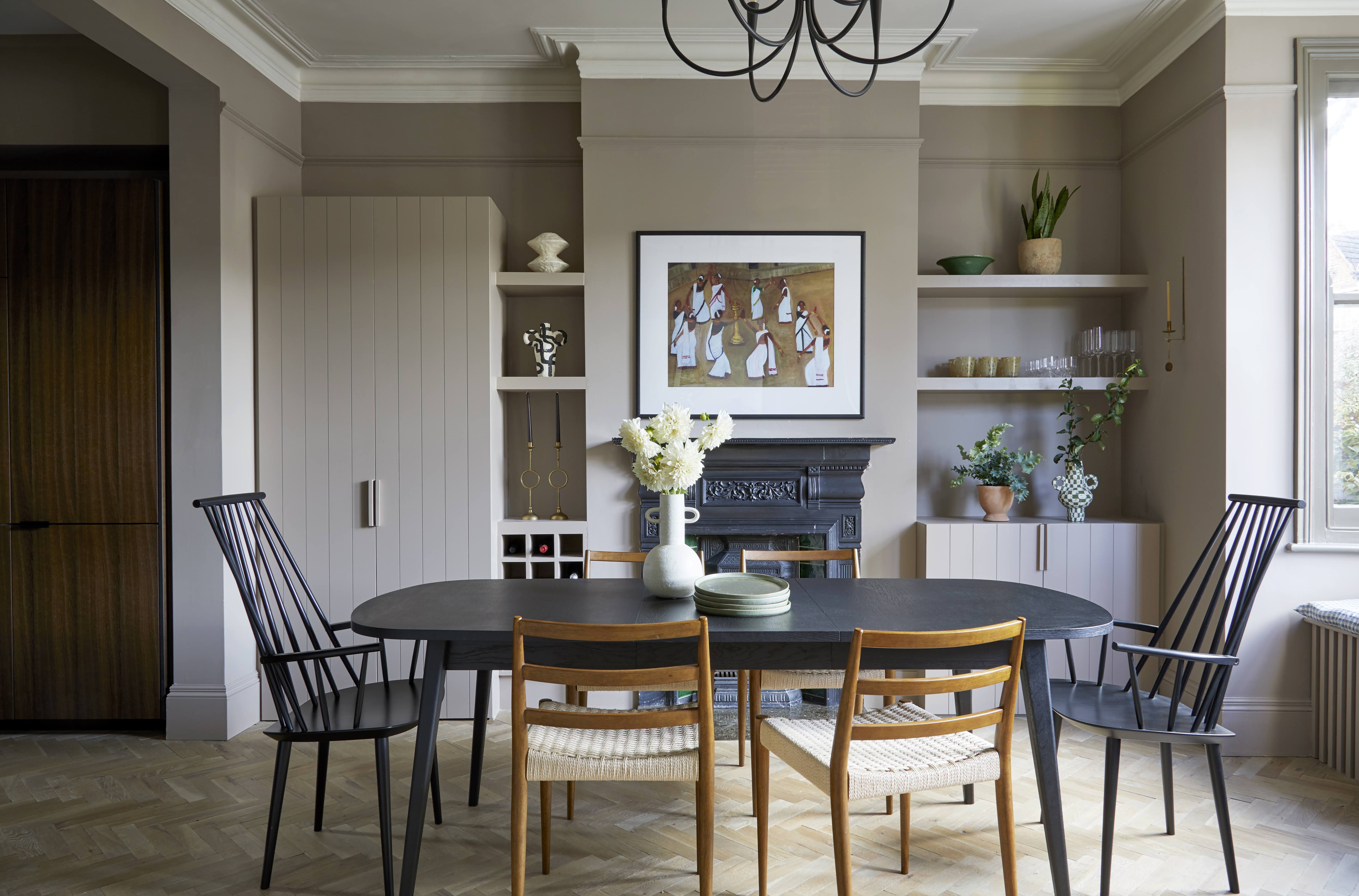
As we enter the fall season, many of us like to cocoon our homes. If you're up for a fresh paint job, then the best dining room colors would be warmer tones. Fall is the perfect time to embrace warm shades as the palette outside ranges through the whole warm side of the color wheel. Browns, camels, oranges, deep greys, and taupes become dominant tones, that have an inherent, cozy feel to them.
Also, warm colors advance while cool colors recede. This means, that if you paint a room with tones of yellow, red, or orange, chances are that the room will feel as though it is contracting, thereby making it feel more enveloping and warm.
'Making a dining space cozy and cocooning doesn't necessarily mean opting for a darker toned wall paint,' says Andrew Griffiths, founder of A New Day. 'In this space, we used a beautiful taupe hue across the walls to bring warmth and softness to the space, without overpowering. The color still reads as quite a subtle neutral, but the warmth of a milky coffee ensures the dining space never feels cold or sterile, whatever the season or time of day.'
2. Opt for an earthy material palette
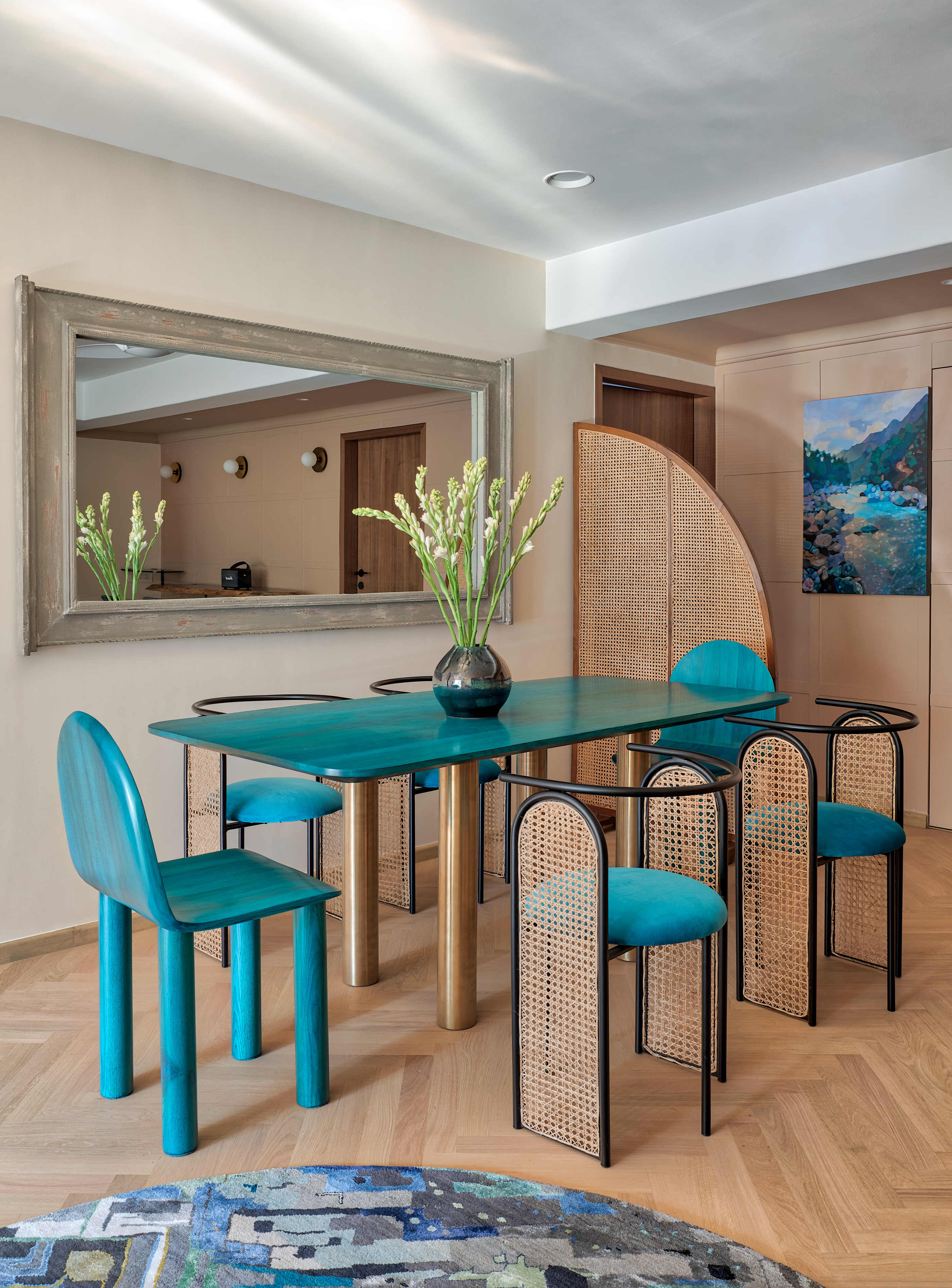
Rattan, cane, and other woven furniture have a long history, stemming from Egypt, moving on to Rome, then England, India, and finally, the U.S. in the 1840s. For years, the infinite possibilities with a raw cane have been expanded upon, and today, this material is universally loved and widely used.
The Livingetc newsletters are your inside source for what’s shaping interiors now - and what’s next. Discover trend forecasts, smart style ideas, and curated shopping inspiration that brings design to life. Subscribe today and stay ahead of the curve.
Rattan is lightweight, does not attract mold, or dust, and is relatively easy to clean. Plus, the material can be molded into several different designs, making it a surprisingly modern furniture idea. From French cafe chairs to sleek dining chairs and more, this material is truly versatile.
'Minimalist chairs in cane, with a slim dining table, is the ideal solution for small rooms, especially in apartments,' says Kapoor, founder of NKD Design Studio. 'Cane chairs give the illusion of extra room. Narrow furniture legs help keep this segment of the house feeling open and relaxed.'
3. Decorate the room with plants and flowers
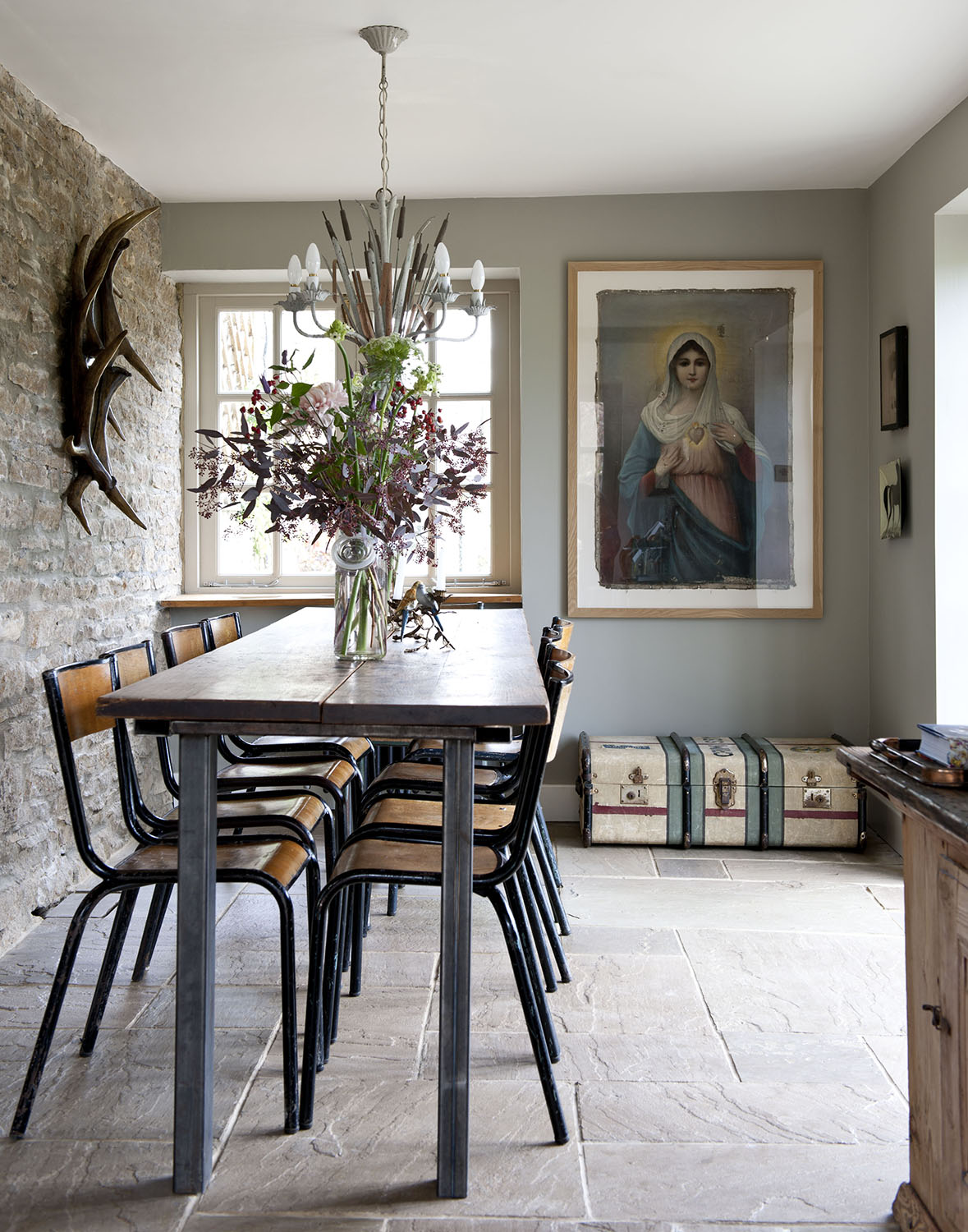
A small touch that is easy to do, it's amazing to note how much cozier a room feels with flowers in it. Warm up the decor with eye-catching wild flowers, pampas grass, and more.
'My go-to is saving all of our fresh hydrangea arrangements well after they have dried up and use them for fall arrangements on the dining table,' says Lance Thomas, founder of Thomas Guy Interiors. 'Dried florals are the perfect decor for getting in the fall spirit when it still feels like summer outside. Avoid overworking arrangements and decor. It should look effortless. To take care of your hydrangea, simply cut a branch, for example, and stick it in a vase of water. Show the intention, not the labor.'
4. Experiment with color drenching

Let color envelop your interiors. Bright shades bring a feeling of warmth and coziness to your space, and wrapping your room up in them will feel a little like a hug.
Color drenching is the concept of using the same hue in different forms throughout the space, by painting the ceilings and walls the same color; and sometimes even the decor elements. This will help uplift your dining room and give it character.
Keep in mind though, that drenching the same tone throughout your space can become overwhelming if you don't think it through well. If you're sold on this idea, consider bringing in swatches of paints and adding them to your walls to visually understand how the space will look.
If you're unsure of bold hues, soft colors of light grey, green, or lavender could work. ‘Today it's all about using color creatively whilst maintaining a sense of calm to counteract external influences,' says Albany's John Ashton. 'Exploring different paint finishes in the same hue with color drenching and monochromatic schemes add interest whilst remaining restful and uncluttered.’
'Bold color is used to complement and strengthen the power of the sea view, not to suppress it,' says architect Stamatios Giannikis. 'Pastel green is used to create serenity in the functional spaces, and flamingo pink is used to frame the actual azure blue of the Mediterranean Sea that can be viewed from the apartment.'
5. Add a rug
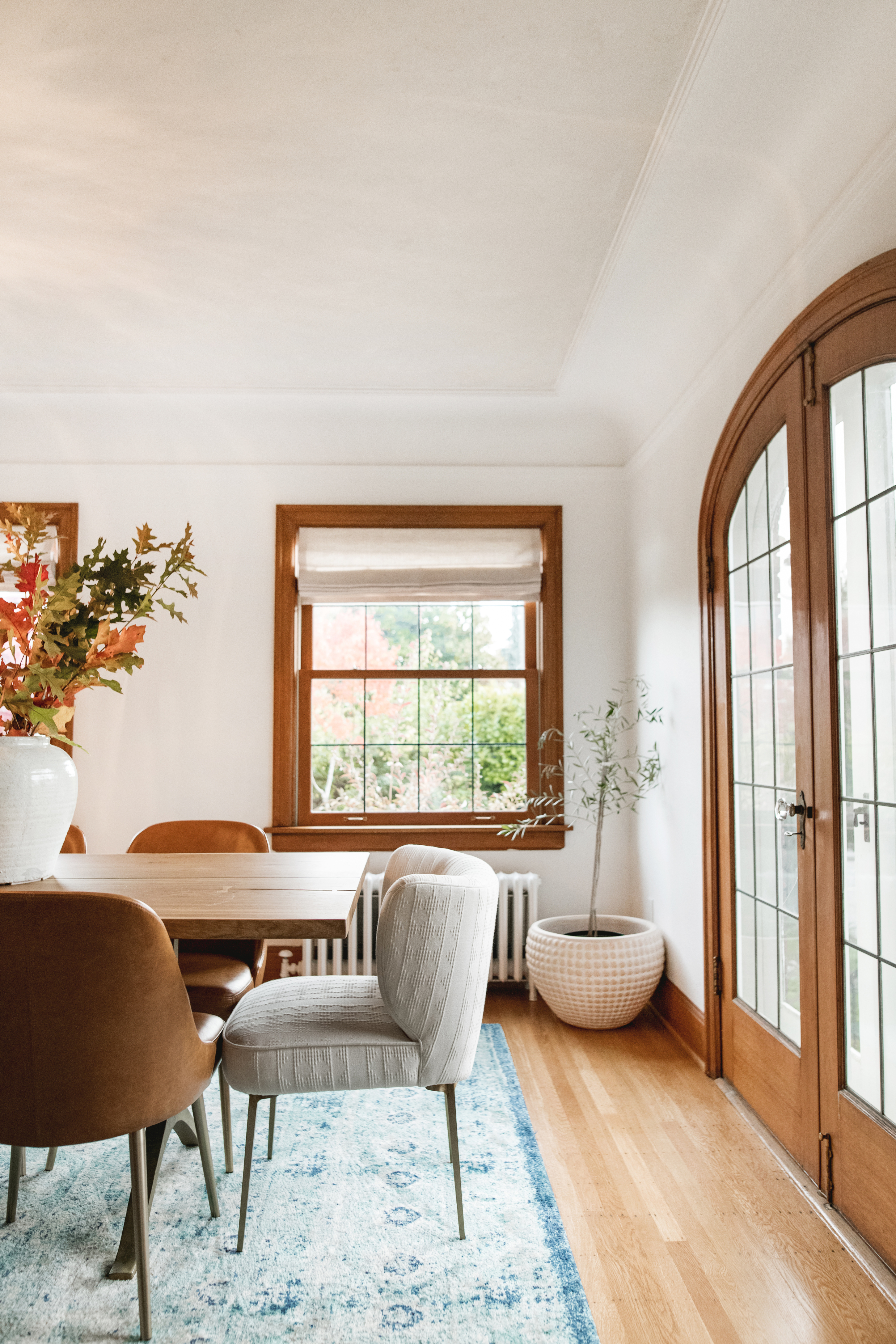
Rugs aren't just for beauty; they can transform a space, define a style, soften visuals and even serve as a starting point for decorating a room. These versatile pieces also help in layering, provide the cozy factor to most rooms and add texture and color.
While designing the dining room, an important factor to consider is selecting the right size rug for your space. In this room, it is best to have enough rugs for the chairs to slide in and out without getting caught on the edge of the rug. If you have an open plan space, you could even use the rug as a subtle divider between the dining and the other areas.
6. Consider wall panelling

Try wainscoting or wall paneling to instantly give more substance and a stylish character to the dining room. While this interior detail is rooted in traditional architecture, it can also enhance a home with a more modern appeal, plus it offers a charming touch to the room.
Consider installing horizontal panels all around the room to create a wraparound look. Plus wood, an inherently warm material will give your space all the snugness it needs.
'An interesting yet off-beat way to cozy up the dining room is with wall treatments, such as paneling or wainscoting,' says Noorein Kapoor, founder of NKD Design Studio. 'These not only give a wonderful architectural effect to the room but also provide texture to a one-dimensional space.'
7. If redesigning, go for wooden flooring

Wood floors are a classic addition to any home, and when correctly installed, can add warmth, character, and value to your interior. There are several varieties you can choose from, based on your budget, the climate where you stay in, and the look you want for your home.
Oak is highly resistant to dents and deep scratches and has a distinct grain pattern. Ash is a harder wood than even oak and can hold stains, traffic, and dents with ease. Pine, is technically not hardwood, though its hardness varies with the species of pine used. It has a natural, reddish-gold tone which is why it makes for a popular option.
Engineered wood flooring can be difficult to distinguish from a solid plank floor when installed. When compared to natural wood, engineered wood is more resistant to moisture, and is more stable. It can also last over 100 years if maintained well.
'We are very inspired by natural materials, so we usually prefer an authentic look in our projects with either natural wooden flooring (planks/chevron/herringbone) in classic tones such as warm oak, light Nordic whitewash, walnut, or even black for the right room,' says Cat Dal, founder of CAT DAL Interiors. 'If you are choosing a timber, look carefully at the other timbers in the room, and either go for a similar tone or contrast it, so there is some definition to the space.'
8. Add softness to the dining room with a curving or circular table
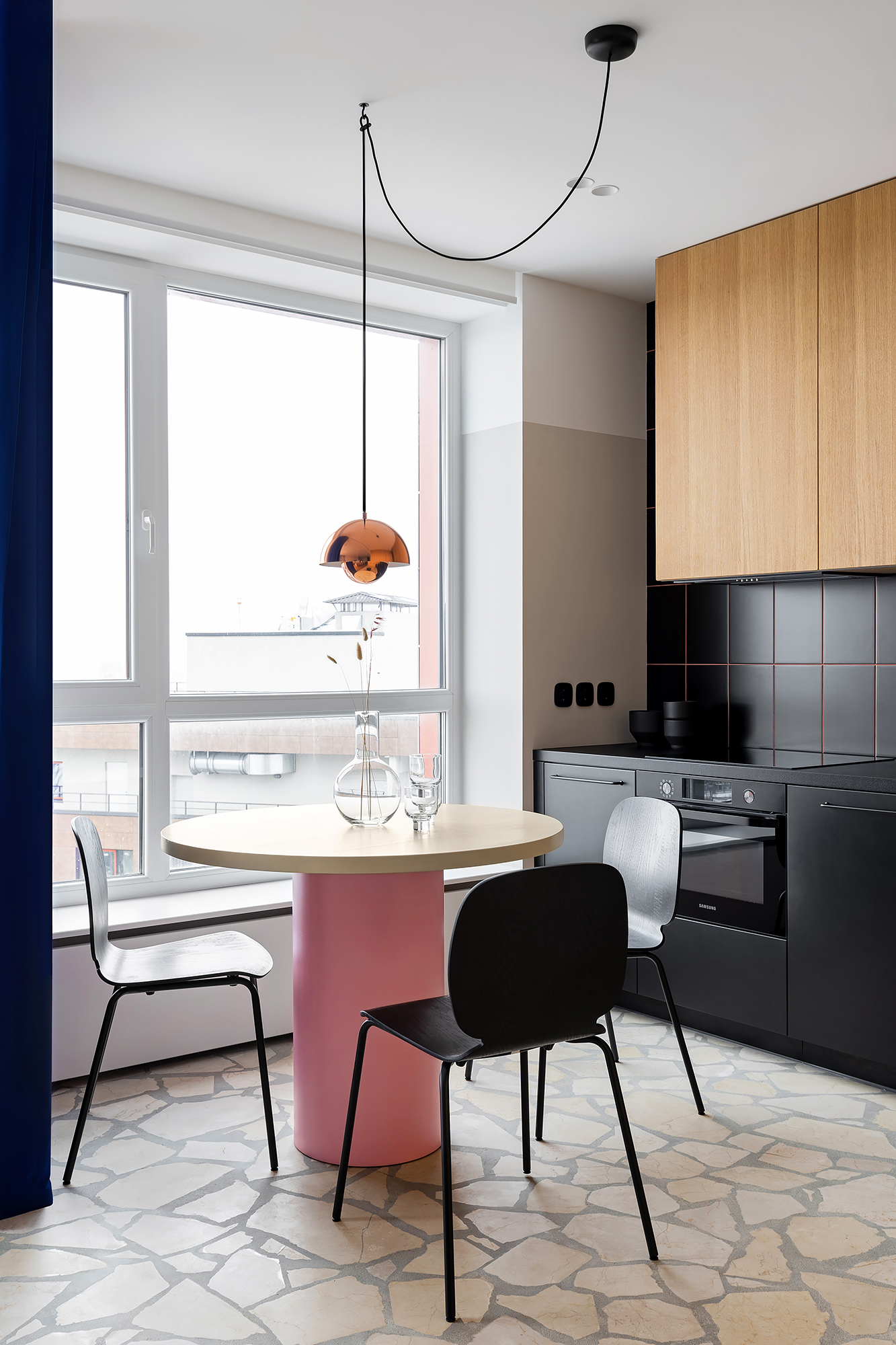
Sometimes it's nice to not have a head of the table. A round table is an ideal piece if you have a small dining room; this piece also makes conversations easier (it's hard to eat and talk to a person who is right next to you!). Round tables or curving furniture don't have sharp edges for you to bang into, which many tend to do on a rectangular dining table.
'There is something about human beings inherently relating to curves,' say Nipa Doshi and Jonathan Levien, founders of international interior design brand Doshi Levien. 'In any case, you don't want sharp corners when you're sitting down.'
Other than perfectly round tables, you could also consider oval pedestal tables that have plenty of room for squeezing in a few extra seats.
9. Bring in a designer mood lighting
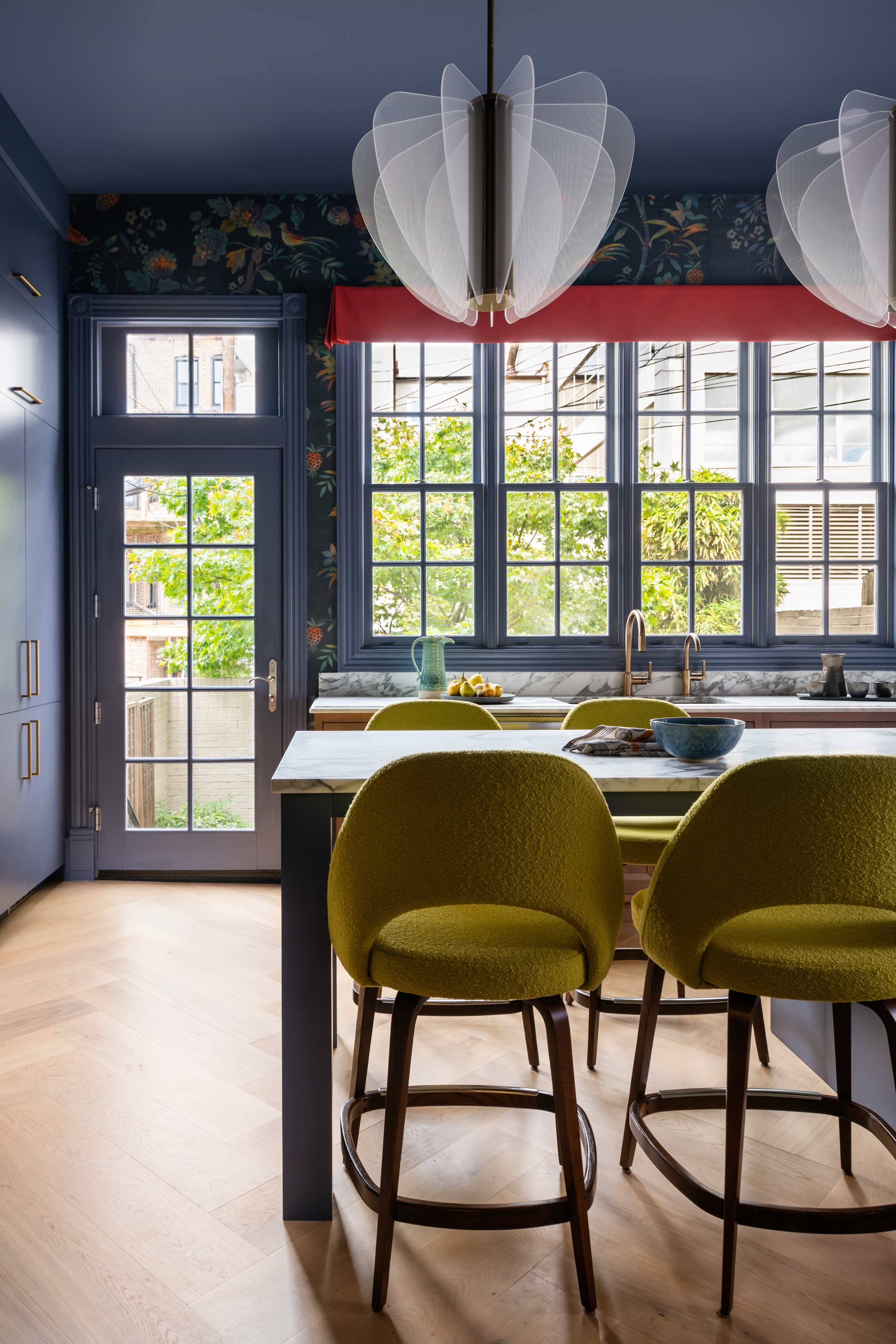
Lighting is a design tool full of wonders. It can illuminate a room and give it a boost in energy and lift a dull vibe. It can also calm down a room, make it feel moody, and in a sense, slow down its vibe.
For relaxing dining room lighting ideas, go for fixtures that look eye-catching yet do not overwhelm you. Add a pendant or even a row of suspended bulbs that cast a warm, yellow glow below. You can layer it up with a wonderful floor lamp in the corner, to ensure the space isn't too dark, nor too bright. Ensure the lamp directs the light downwards, and aim to have the bottom of the shade sitting around eye level.
Another way to add to the room's lighting scheme is with table lamps. Have a console in the dining room? A set of two matching table lamps on eye level will provide a layer of soft, low-level mood lighting for when it’s time to dial things down.
10. Give low seating a try
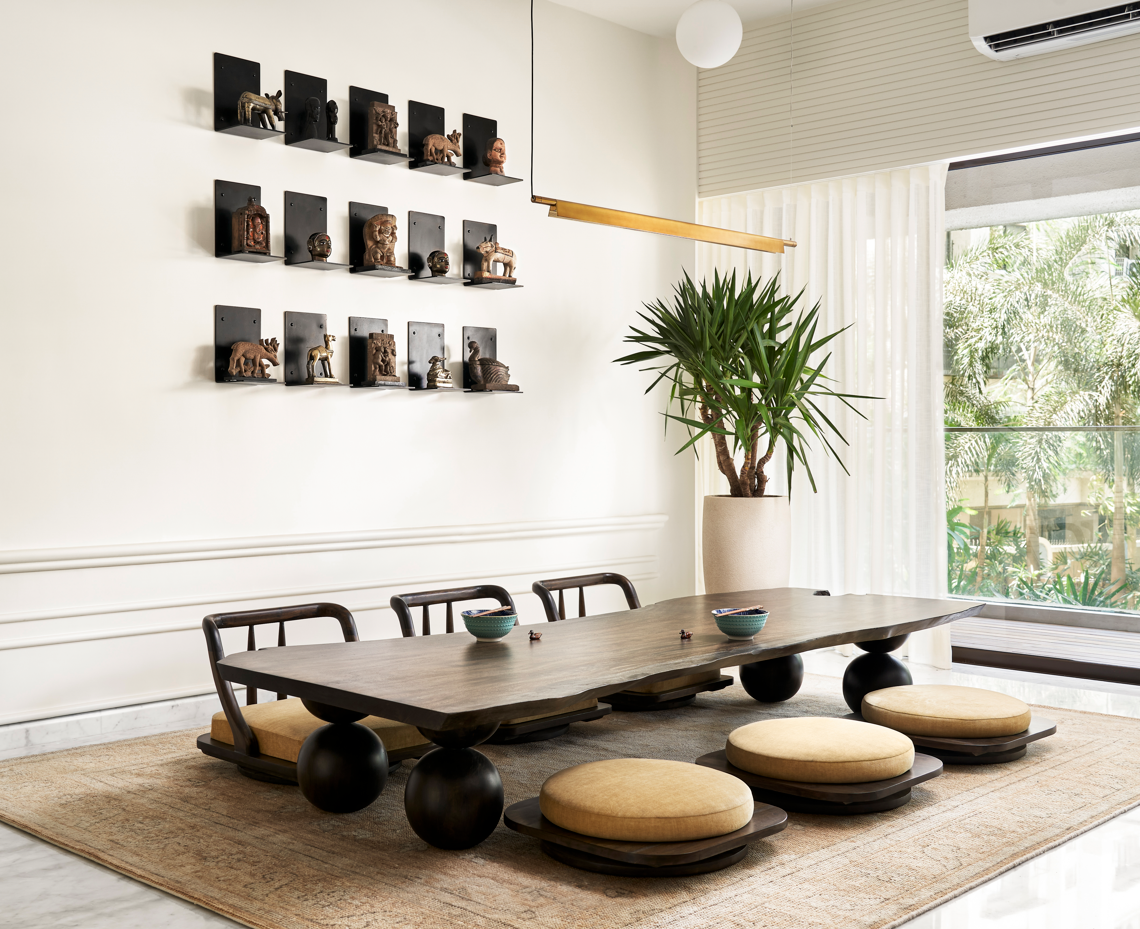
Alright, this may seem a little out there for many, but in the Asian culture, low or ground seating is a staple, and for good reason. It not only has health benefits but decor-wise, adds an intimate feeling as no other seating system does. Plus, did you know it's a big dining table trend for 2023?
Largely it is believed that sitting on the floor while dining aids digestion, increases blood circulation, and even relaxes the mind and body. Think of the sense of calm you feel when you sit cross-legged at a park.
Floor seating also encourages people to gather around more closely, and feel less conscious. Conversations tend to flow seamlessly, and the vibe immediately becomes more casual. Ideal for dinners with close family and friends.
Of course, you want to make sure your floor or low seating isn't such that it makes you touch the cold ground and works counterintuitively. Consider adding thick rugs, and plenty of cushions to cozy up the seating. If you have the option of heated floors, you're golden!
'Floor seating is considered healthy in ancient Asian cultures and with all things retro making a huge comeback now, this type of low dining seating will be big in the coming years,' says architect Shiraz Jamali. 'This seating also opens up the space and makes the room feel more open and relaxing. We used a rustic live edge wooden table and added unusual carved wooden balls for legs creating an interesting blend of styles.'
What makes a dining room comfortable?

There are several ways to make a dining room more comfortable. For starters, choose furniture without sharp edges, as you don't want yourself or your kids getting hurt as you move around in the room.
'Upholstered seating to match the drapes is a great way to add a warm vibe to the dining room,' says interior designer Mary Patton. 'I also love adding a sofa or loveseat to breakfast rooms or dining rooms. In this space, I found the chairs on Chairish. These are vintage pieces and we lacquered them blue and re-upholstered them in a pink Schumacher velvet.'
Wall colors and paint techniques make a big difference too when it comes to designing an inviting space. Even dining room wallpapers that showcase soft palettes and dainty motifs work well. Other than that, you could consider layering the room with plush textiles, insulating window treatments, and adding thick and cushiony rugs.

Aditi Sharma Maheshwari started her career at The Address (The Times of India), a tabloid on interiors and art. She wrote profiles of Indian artists, designers, and architects, and covered inspiring houses and commercial properties. After four years, she moved to ELLE DECOR as a senior features writer, where she contributed to the magazine and website, and also worked alongside the events team on India Design ID — the brand’s 10-day, annual design show. She wrote across topics: from designer interviews, and house tours, to new product launches, shopping pages, and reviews. After three years, she was hired as the senior editor at Houzz. The website content focused on practical advice on decorating the home and making design feel more approachable. She created fresh series on budget buys, design hacks, and DIYs, all backed with expert advice. Equipped with sizable knowledge of the industry and with a good network, she moved to Architectural Digest (Conde Nast) as the digital editor. The publication's focus was on high-end design, and her content highlighted A-listers, starchitects, and high-concept products, all customized for an audience that loves and invests in luxury. After a two-year stint, she moved to the UK and was hired at Livingetc as a design editor. She now freelances for a variety of interiors publications.